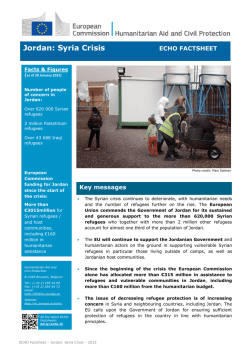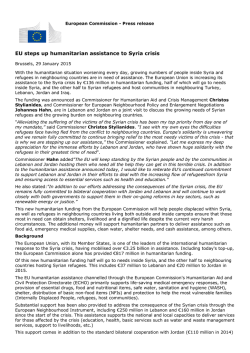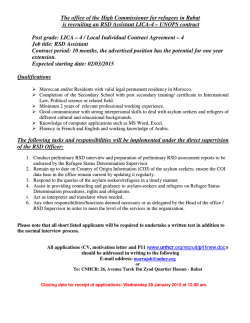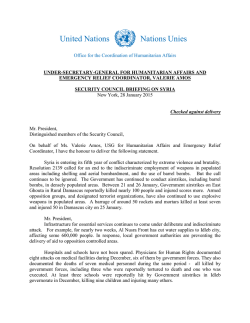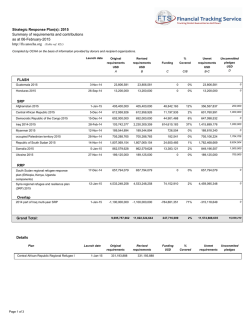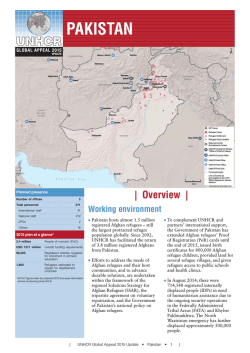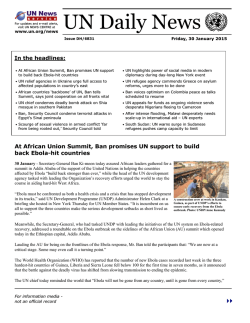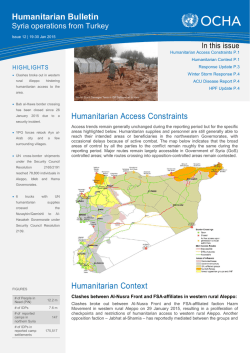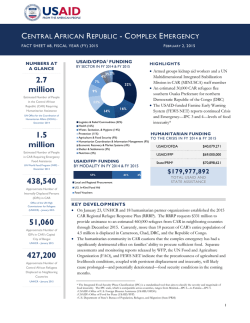
Syria Regional Refugee Response
UNHCR/A. Branthwaite PREVIEW “The 3RP is a country-driven, regionally coherent plan to address refugee protection and humanitarian needs whilst building the resilience of vulnerable people and impacted communities and - recognizing the centrality of national resilience and stabilization plans - strengthening the capacity of national delivery systems.” population size refugee population 77.3 million 1,065,092 of total 1.4 % population TURKEY 22.9 million 4.5 million 3.2 million 1,137,729 of total 25.3 % population fleeing Syria to neighbouring countries SYRIA LEBANON 35.9 million projected to reach 1.6 m (37% of total population) by the end of 2014 215,387 of total 0.6 % population JORDAN 85.8 million 140,023 of total 0.2 % population EGYPT IRAQ 6.7 million 619,376 of total 9.2 % population Figures of Syrian refugees, registered and awaiting registration as of 16 October 2014. CONTEXT The conflict in Syria, which will be four years old in March 2015, shows no sign of abating. It has caused the largest refugee displacement crisis of our time, and has severely strained the economic and social systems and related institutions in neighbouring countries. There are now over 3.2 million registered refugees from Syria hosted in Lebanon, Turkey, Jordan, Iraq and Egypt, and conditions in Syria continue to deteriorate. An additional 100,000 refugees have arrived every month in search of safety and protection throughout 2014. The influx of refugees from Syria has added to the large numbers of Palestinian refugees and refugees from other countries in the region. With the crisis dragging on, refugees are exhausting their savings and resources, becoming more vulnerable, and remain in need of life-saving humanitarian assistance. New arrivals are increasingly arriving after having already been internally displaced multiple times before seeking safety abroad. A worrying number of refugees are taking desperate measures to flee the conflict, risking their lives by crossing conflict lines or on boats. Around 85 per cent of the refugees from Syria in the neighbouring countries are living in local communities - outside of formal camp settings and widely dispersed in the community - posing an additional challenge to the overall response. Mounting demands for municipal and government services and support are resulting in additional economic, social and political pressures on fragile local communities. In many sectors, such as health and education, development gains achieved prior to the conflict are being reversed. Economic insecurity and increased competition over scarce resources, opportunities and services are fueling social and political tensions among and between refugee and impacted communities. Further, neighbouring countries have been impacted at a time when they were already combating internal economic and social challenges, with the economic collapse in Syria further affecting their economic performance, public finances, trade deficits and key economic sectors such as agricultural food and trade, thus limiting the resource base of host countries to cope with the effects of the crisis. Combined with developments in Iraq, the Syria crisis poses a growing threat to regional peace and security, and the international community must show solidarity with those governments so generously hosting millions of refugees from Syria. THE CASE FOR AN INTEGRATED RESPONSE As the protracted crisis enters its 5th year, the needs in this region and around the world have never been greater. The ability of the international community to address those needs with only humanitarian assistance is diminishing. A paradigm shift is warranted. Growth in global humanitarian funding – already at a record high in 2013 of US$ 22 billion – is no longer keeping pace with accelerating needs, requiring a fundamental rethink of both humanitarian and development financing, deployment of domestic resources and the activation of the private sector. In the context of the scale and duration of the Syria crisis, essential humanitarian assistance must be coupled with an approach designed to build, strengthen or restore the resilience of individuals, communities and institutions, so they are capacitated, resourced and better able to respond to the protracted crisis. The need for a resilience-based development response to support host communities and countries was developed and articulated by the United Nations Development Group (UNDP in its Position Paper “ A Resilience-based Development Response to the Syrian Crisis” (October 2014). 2 The 3RP process gives practical life to this vision by supporting the development and implementation of nationally-led plans within a regionally coherent response to humanitarian and development needs. The 3RP is a step forward in reflecting the principles set out by the Comprehensive Regional Strategic Framework developed in May 2014, as well as the lessons learned from earlier versions of regional plans. Investing in people through local and national resiliencebuilding will not only reduce the costs of humanitarian responses in the short and medium term, but also help affected communities and national systems to cope with the effects of the crisis on a more sustainable basis. The 3RP acknowledges the centrality of national ownership in securing a more effective and sustainable management of the effects of crisis in neighbouring countries. The 3RP reflects on priorities for action set forth in existing ‘integrated’ national response plans in Jordan (the Jordan Response Plan 2015, including the National Resilience Plan) and Lebanon (Lebanon Crisis Response Plan, including the Roadmap of Priority Interventions for Stabilization from the Syrian Conflict in Lebanon). It also supports on-going planning efforts in other neighbouring countries. This ensures synergies between international development assistance and domestic financing of the response, as well as alignment with longer-term development plans, including the United Nations Development Assistance Framework (UNDAF). The 3RP is undertaken within the Comprehensive Regional Strategic Framework (CRSF) objectives and goals, in line with the UNDG Position Paper on “Resilience-based Development Response to the Syria Crisis”, and alongside the Syria Humanitarian Assistance Response Plan (SHARP) for humanitarian needs within Syria. “Refugees may be a humanitarian issue... but it has a direct relationship with development issues. There should be no separation between humanitarian and development”. UN Secretary-General, Ban Ki-moon, 1 October 2014 The No Lost Generation (NLG) initiative is part of the 3RP. The NLG is designed to draw increased attention to the under-resourced sectors of education and child protection. The NLG represents exactly the approach that the 3RP is adopting, in that it is calling for simultaneous humanitarian and development action to address the risk of a lost generation of Syrian children. The NLG priorities are also embedded in the Stabilization Plan in Lebanon and the National Resilience Plan in Jordan. 3 4 UNDP/ Martin Edström WHAT IS THE 3RP The 3RP builds on the successes of the existing Syria Regional Response Plan (RRP) model with a new, innovative approach that brings together humanitarian and development interventions for a sustainable resiliencebased response to the Syria crisis in support of refugee hosting countries in the region. It is a platform for planning, advocacy, fundraising, information management and monitoring that brings together refugees, nationals of host countries, more than 150 development and humanitarian actors, civil society, and the Governments of Lebanon, Turkey, Jordan, Iraq and Egypt. The 3RP recognizes the centrality of national resilience and stabilization plans and seeks to strengthen national and subnational planning and implementing capacities. Resident Coordinators/Humanitarian Coordinators and the heads of the respective UN agencies have already and continue to provide strategic guidance and coordination in the design and eventual implementation of the 3RP. The 3RP consists of five Country Plans, developed at the national level in close consultation with national governments. It is based on bottom-up, inclusive planning to benefit from diverse views and capacities and ensure transparency. While the 3RP is a country-driven process, it is also a regionally coherent plan; the 3RP Regional Overview will draw together the overall strategic and operational direction and high-level analysis and reporting. The 3RP will cover a period of two consecutive years (2015 and 2016). There will be a one-year detailed plan and implementation phase for 2015, with indicative requirements for 2016. 5 3RP OBJECTIVES The 3RP aims to address refugee protection and humanitarian needs, whilst building the resilience of impacted communities and strengthening the capacity of national delivery system, including through national crisis response plans. It is a strategy to address the adverse social, humanitarian and economic impacts resulting from the Syrian conflict and an unprecedented ‘demographic and economic shock’ arising from large refugee inflows. The 3RP has two inter-connected components in a single plan: • Refugee protection and humanitarian assistance will address the protection and assistance needs of refugees living in camps, in settlements and in local communities in all sectors, as well as the most vulnerable members of impacted communities. It will strengthen community-based protection through identifying and responding with quick-impact support for communal services in affected communities. • Resilience/Stabilization-based development will address the resilience and stabilization needs of impacted and vulnerable communities in all sectors; build the capacities of national and sub-national service delivery systems; strengthen the ability of governments to lead the crisis response; and provide the strategic, technical and policy support to advance national responses. 6 UNHCR/Jared Kohler POPULATION PLANNING AND SCENARIOS All signs indicate that the human costs of the crisis are increasing, population movements accelerating and vulnerabilities widening. them to meet their basic needs including shelter and food, and thus protection space that refugees enjoy might be negatively affected. The overall planning assumptions for 2015 are for continued violence and insecurity inside Syria, lack of political agreement to facilitate sustainable peace, limited, if any, voluntary refugee returns, and continued refugee outflows at similar magnitude to current trends. The 3RP framework envisages, and actively supports and encourages, increased government ownership of the planning and implementation to address the most pressing humanitarian needs. While each host country will determine its refugee planning figure in the final 3RP Country Chapters, based on its contingency planning model, an initial overall estimate is that an additional 900,000 Syrian refugees might arrive in the five host countries during 2015. This would mean a refugee planning figure across the region of around 4.6 million by the end of 2015. Given the growing international concern about regional stability, there is an increased imperative for international solidarity and burden-sharing to help host governments alleviate the impact of the Syria situation. In the refugee host countries, it is expected that the protracted emergency will deplete the resources of refugees and decrease the capacity of the most vulnerable among Moreover, the refugee crisis is impacting millions of vulnerable people living in local communities. Countries in the region experience considerable poverty rates (14 per cent (Jordan), 26 per cent (Egypt) and 28.5 per cent (Lebanon)). Refugees crowd already poor and vulnerable areas with limited livelihoods, housing and social services capacities further exacerbating the vulnerabilities of the local population. Under the existing RRP6 framework, some 2.7 million members of impacted local communities are expected to be assisted this year. In line with the 3RP’s expanded scope in terms of assistance to national systems and resilience-building in impacted communities, this figure would be expected to be significantly higher for 2015. The number of members of impacted local communities to be assisted will be finalized following the submission of each country’s final 3RP plan. 7 REGIONAL PRIORITIES The 3RP will implement a strategic shift in the response to the crisis in Syria’s neighbouring countries. While recognizing that ensuring refugee protection, meeting humanitarian needs and implementing life-saving interventions are critically important and will be prioritized, these will be combined with commensurate efforts to enhance self-reliance opportunities for the vulnerable and strengthen the capacities of national and local systems to cope with increased demands and provide access to quality services to populations in most affected communities on a sustainable basis. Refugee protection, capacity building of national and local service delivery systems and enhancing social cohesion, especially through the creation of livelihood opportunities are three of the overarching priorities of the 3RP approach. Strengthening Protection of Refugees Refugees from Syria continue to be in need of international protection and thus access to territory, protection from refoulement continue to play a key role along with access to registration and documentation including civil registration, especially birth registration. Access to legal assistance and remedies need to be strengthened. Families and communities 8 are engaged and empowered to contribute to design of the programmes and identification of appropriate solutions to the problems that they face. Women, girls, boys and men with specific needs are identified systematically and their needs are addressed through specialized services and interventions. Outreach mechanisms to refugee populations including additional community centers are further strengthened and two-way communication between refugee and impacted communities are maintained promoting social cohesion and peaceful co-existence. Risks related to SGBV that girls, women, boys and men are mitigated through strengthening capacities of the government and NGOs and supporting community-based protection activities. Efforts to support national child protection systems, supporting children’s families and communities for better protection remain the key strategic directions of 3RP along with ensuring access to specialized child protection services to respond to a broad range of concerns (including unaccompanied and separated children, child labour, early marriage, exploitation and detention), focusing on family unity, quality education and protecting children from violence in the homes and at schools. The 3RP will continue and mainstream protection and gender across the interventions for refugees, with the overarching principle of equal and non-discriminatory availability of and access to protection and assistance for women, men, girls and boys. Delivery of assistance in safety and with dignity, engaging refugee communities in development of programmes and adherence to the principle of ‘Do No Harm’ are the guiding principles. Strengthening the resilience of refugees, particularly women and girls – who comprise the majority of the registered Syrian refugee population – will also be a central objective of the 3RP. Addressing Capacity Gaps of National and Local Service Delivery Systems The production of country plans represents substantive progress in terms of widening the scope of analysis of the impact of the crisis, expanding partnerships for a more sustainable response and fostering national responsibilities and ownership. This will ensure synergies between international development assistance and domestic financing of the response, as well as alignment with longer-term development plans. The 3RP acknowledges the growing pressures that the crisis is placing on already strained national and local systems. Addressing service delivery capacity gaps, through the provision of technical expertise, policy advice, administrative and coordination support, is a priority under the 3RP, as well as direct support to service delivery (such as education and health facilities, solid waste management) for communities most impacted by the refugee influx. The RRP6 Mid-Year Review noted that national service delivery systems (health, education, and municipal services for example) are witnessing large increases in demand and require additional capacity to maintain service levels and quality as well as to meet the specific needs and situation of refugees. The RRP6 Mid Term Review Report contains a number of “alerts” regarding the growing gaps resulting from inadequate support to national and local service delivery systems, and to the expansion of livelihoods and employment opportunities, including attendant risks to social cohesion and unity. For example, in the education sector, although some development funds have been made available to host countries, more is required to address the identified gaps in terms of capacity of national systems and quality of education. Greater investment is needed in the formal education sector to ensure that increased numbers of refugee children benefit from quality education. Key policy constraints such as the need for certification for Syrian refugee students must be addressed. This is particularly important in areas where the displaced place the greatest burden on the education 9 system, and the case of Iraq is particularly complex where many schools have been occupied by IDPs. The capacity of urban services and municipal authorities to cope with increasing demand in water and sanitation, waste management and energy is also under major strain. There is a growing consensus among stakeholders that a strategic WASH priority is to ensure that refugees and nationals have access to sustainable water resources, reducing the necessity for water trucking. Actors are intensifying efforts begun in 2014 for more efficient and cost effective water and sanitation systems. Supporting Social Cohesion The 3RP recognizes the need to pay greater attention to social cohesion issues. An increase in competition for scarce resources, housing, and employment opportunities and a decline in the standard of living limit interactions between communities and increase protection and security risks. Perceptions of host communities and stereotyping may contribute to distrust and conflict. According to recent surveys conducted in the Bekaa and Akkar regions among refugees and host communities, over 90 per cent of Lebanese perceive refugees from Syria as an economic threat and underlined a rising threat of violence between 10 the two populations. Preserving and promoting social cohesion is key to securing the level of human security that contributes to the overall effectiveness and sustainability of the response, and is vital for future development in all communities affected by the crisis. Through livelihood, infrastructure and other socio-economic interventions that involve both refugees and vulnerable populations, the 3RP aims at enhancing mutual trust, collective action and participation and solidarity in all affected communities. This includes cash for work programmes in public infrastructure but also financial and technical support to the Micro, Small and Medium Enterprises (MSME) which is the sector responsible for the vast majority of new economic opportunities. Proposed programmes will encourage households and individuals to build an asset base through work and savings programmes. This will go along with efforts to strengthen local and national institutions that promote dialogue, social cohesion and rule of law. Adolescents and youth (10-24 years old) are a particular risk group in need of basic services such as health, education, protection, vocational training, life skills and recreation. If these needs are not met, there may be a long run impact on resilience and the prospects for future peace, as the young people who are not engaged in positive learning activities can lead to negative coping strategies. ENHANCED VULNERABILITY ANALYSIS FRAMEWORK There are large differences between country contexts, refugee needs and vulnerabilities, means of delivery between humanitarian and development programming, and existing national capacities and services in the region. Therefore, developing region-wide comparisons of needs, vulnerabilities and costs across the response is extremely difficult. Notwithstanding, the 3RP must respond simultaneously to the requirements of refugees with specific needs; refugees with socio-economic vulnerability who are in need of food, WASH, basic items and other forms of immediate to medium term assistance; and vulnerable members of impacted communities, as well as addressing the critical stability and social cohesion risks for the host communities/countries. 25 per cent of Lebanese communities. In Jordan, UNDO has developed a vulnerability analysis framework that uses a composite measure of stress (Index of Stress ) that consists of two indicators, namely (a) the national poverty rate (the percentage of households living below the national poverty line); and (b) the number of registered refugees at the local level (as a share of the total population). In Egypt, the Stress Index was being used to prepare an area-based approach to improve the targeting of resilience-based activities. The 3RP will therefore develop multi-dimensional vulnerability analysis frameworks that target humanitarian assistance to the most vulnerable refugees, and prioritize resilience-building and stabilization interventions to the most stressed and vulnerable impacted communities. The 3RP uses a number of tools to support identifying the most vulnerable communities that consider both refugee numbers and the poverty rates in each country. For example, In Lebanon, UNHCR/UNICEF have prepared an Index of Vulnerability that is used to pinpoint the most vulnerable 11 UNHCR/Salah Malkawi SUMMARY: SECTOR SHIFTS Throughout all sectors, protection and gender mainstreaming aims at promoting non-discriminatory access of refugees to protection and assistance programmes, delivering assistance in safety and with dignity, engaging refugees and communities for their own protection and adhering to the ‘do no harm’ principle with an emphasis on women, girls, boys and men. PROTECTION Health Food SecuritY WASH Shelter: Education protection: The protection strategy will continue to focus on access to territory and protection from refoulement; strengthening national protection systems, registration and documentation; protection of women, girls, men and boys from violence, abuse, neglect and exploitation; provision of quality education; and access to key protection services that address specific needs of refugees. Health: The 3RP will pursue a more cost-effective and sustainable approach to health, with a focus on promoting equitable access to effective national systems for refugees and impacted communities. This will be achieved by addressing the following health priorities: • Supporting the resilience of national health systems to cope with increased demand; • Addressing life-threatening health risks such as that of communicable disease outbreaks, such as polio and measles; • Treatment for chronic diseases (hypertension, diabetes and cancer) and adequate services for mental health conditions, as well as disabilities that will impact on the individual patient’s health and impair his/her potential capacity to generate income in the medium- and longer-term; • Investing in measures that serve to respond to the immediate humanitarian situation whilst bolstering infrastructure, such as strengthening the epidemic surveillance and response systems; The development of parallel mechanisms will be discouraged. Basic Needs Social Cohesion and Livelihoods 12 Food Security: Assistance to refugees who are foodinsecure (or at risk if assistance were to cease) will continue and, where possible, include livelihood support and cash for work. In order to promote social cohesion and parity, assistance will also be offered to the most vulnerable members of impacted communities. For refugees living outside of camps, further targeting is foreseen to reach out to the most vulnerable with the funds available. The transition from in-kind food and paper voucher to e-voucher will be completed, and the One-Card modality will be expanded. Small-scale family agriculture production will be supported to improve food security and income generation from sale of agriculture products. WASH: In camps and informal settlements, 3RP intends to make WASH services more efficient, sustainable and economical by continuing the transition from temporary solutions such as water tanking and communal latrines to piped networks, proper drainage systems and household level latrines linked where possible to existing municipal systems. Outside camps, the focus will be on working with impacted communities and host governments to improve and strengthen the capacity and robustness of existing services, to cope with the increased number of beneficiaries, at the same time leaving behind improved infrastructure, services and policies, such as water scarcity adaptation, that will remain in place beyond the crisis. Shelter: Around 85 per cent of refugees are living outside of camp settings, in local communities. All refugees, including those inside and outside of camps, will be supported to engage more with the local community. Additional investments in shelter will be made, not only to increase the supply and quality of individual housing units but also to improve overall infrastructure (ie: urban planning and amenity) and policy settings (ie: housing, land and property legal issues) in impacted host communities. Education: The 3RP will prioritize efforts to ensure nondiscriminatory access for refugee children to benefit from formal education throughout the region, including maintaining and expanding as necessary second shifts as important means of reaching as many students as possible. Access to quality, accredited non-formal education and engagement of civil society remain important to scale up access to learning for out of school children. Cost-effectiveness when investing in education is a valued approach throughout the region. Policy challenges, including the certification of Syrian refugee children, will be addressed. Basic Needs: Whenever possible, the 3RP continues the progressive shift from in-kind assistance with basic non-food items to unconditional monetized assistance, prioritizing improved targeting to use the available funds to reach those most in need without compounding vulnerabilities. This allows refugees to have more dignity and choice, as well as injecting cash and thereby supporting jobs and livelihoods in their local communities. The scaling up of these cashbased responses will be undertaken with a strong focus on maximizing synergies with national systems, especially in terms of transferring knowledge and capacity. Social Cohesion and Livelihoods: Increased attention on livelihoods, self-sustainability and public works for the mutual benefit of refugees and impacted communities is a key 3RP component, where an additional investment of resources is required. Through effective resilience-based programming, these investments will help to stabilize refugee families, impacted communities and host governments, contributing to generate employment and preparing a more sustainable future. Investments in the creation of economic opportunities now will save money in just the medium but also the short term. The plan’s efforts in livelihoods will provide economic opportunities, especially to its youth, and will also have sustainable fiscal positions, adequate social service systems and expanded safety nets. Priorities in the livelihoods sector will be strengthening self-reliance and creating economic opportunities such as job creation and supporting micro and small business. The 3RP will promote investments in public infrastructure in local communities, helping to ease the strain placed on this infrastructure by the presence of large numbers of refugees. 13 COUNTRY SUMMARIES LEBANON The conflict in Syria has drawn a strong humanitarian response in Lebanon, ensuring that basic needs of refugees and affected Lebanese communities are addressed, in particular through the delivery of services by public institutions. In 2014, between January and September, 400,000 new refugees have been registered bringing the total number of Syrian refugees in Lebanon registered with UNHCR to 1.1 million. The Government of Lebanon estimates there to be an additional few hundred thousand Syrian nationals not registered as refugees. The Syrian refugees join an already existing Palestine refugee population thus making Lebanon the country with the highest concentration of refugees per capita worldwide. Sympathy for refugees remains generally high but Lebanon is feeling the spillover effects of the conflict, primarily manifested by the massive refugee influx, which led the Lebanese Government to take new measures to regulate the entry and presence of refugees on its territory, including stricter border restrictions. As the displacement is becoming protracted, needs are increasing, with refugees’ savings gradually being depleted and vulnerabilities worsening over time. The increase in the 14 refugee population has placed serious strains on already fragile public infrastructures, especially with respect to waste, water and sanitation systems; education, with the public schools able to receive only one third of school aged refugee children; and health, where the high cost of life saving interventions excludes the poorest. This pressure on public service delivery is impacting both refugees and Lebanese. It demonstrates that public institutions at central and local level face a widening gap between the scale of emerging challenges and their capacities to meet them. Lebanon’s poor increasingly demand support to ease their own growing hardships. A third of the Lebanese youth are now unemployed, a 50 percent rise since 2011. The crisis is having a sustained impact on Lebanon’s economy, impacting young people and women disproportionately. In addition, recent research indicates the extent of damage to Lebanon’s already fragile environment from Syria’s conflict – tracking a steep rise in solid waste production and wastewater pollution, as well as deterioration in air and water quality. The Lebanon Crisis Response Plan contextualizes the response to the needs of the vulnerable Lebanese and the refugees within the Government of Lebanon 2013 Stabilization Roadmap. The plan strengthens government UNDP/ Martin Edström leadership in response coordination mechanisms. It seeks to strengthen the capacity of Lebanese institutions to respond to the humanitarian needs and to consolidate development gains that will guarantee the stability of the county. The Plan builds on the achievements of the previous refugee response plans and focuses on expanding delivery of services through government institutions, building community capacities and strengthening social cohesion. Sectors developed cost- efficient strategies, such as an expansion of cash transfers as a modality for individual assistance, and priority interventions targeting the most vulnerable. It continues focusing on a community-based response, through the engagement of communities and local partners (municipalities and civil society), to respond to protection concerns and build families’ and individuals’ capacity to sustain their own well-being. 15 TURKEY The number of Syrian refugees in Turkey, compounded by the recent influx from Ayn al Arab, currently stands at an estimated over 1,6 million and has stretched national structures and capacity to the utmost. Amid an increasingly protracted crisis and growing challenges in raising adequate resources, the 3RP partners are providing humanitarian support and technical expertise to the relevant national authorities, and help foster resilience and sustainability. Strengthening of national protection mechanisms and service providers as well as capacity building activities to the relevant line ministries, with a focus on the most affected areas, has become an increasingly important priority. In 2015, basic needs aid will be more heavily shifted towards cash assistance for non-camp refugees who are more in need and this modality also enables support to the local economy while providing flexibility in meeting a different range of needs of the beneficiaries. At the end of 2014, only 14 per cent of Syrian refugees were hosted in the 22 refugee camps managed by the Turkish 16 Government with 86 per cent of refugees living in urban and rural areas, mainly across the South Eastern part of the country. In 2015 and 2016, further to the expanded and full-fledged registration system by the Government of Turkey with UNHCR technical support, it is hoped that the Government and the 3RP partners will be able to deliver a more targeted protection and assistance response, particularly for the most vulnerable refugees, such as children and women at risk and persons with specific needs. For education, the focus is on expanding access to services ranging from early childhood to higher and adult education and the inclusion of refugee children in the national system along with corresponding referral and accreditation systems. Similarly for health, 3RP partners envisage to support the MOH in developing a comprehensive multi-year health care strategy which will include in particular capacity building of Family and Community Health Centres as primary care providers for Syrian refugees to reduce the burden on hospitals, avoid duplication and uphold the national response to the benefit of host communities and Syrian refugees, whose number continues to pose a major challenge for the public health care system. In 2015 and 2016, the number of non-camp Syrian refugees is expected to continue to increase, further challenging social cohesion and stability. Hence, the livelihoods of the Syrian non-camp refugees as well as of the hosting communities will need to be more strongly addressed, calling for both short term interventions that target primarily the Syrian population and medium-to-long term interventions that aim at increasing the coping capacities of the communities. In comparison to the RRP6, Turkey has thus increased its appeal for the livelihoods sector and has adopted a resilience related approach aimed at benefitting the national and local institutions and host affected population, particularly in the most remote areas of the country. Turkey is currently taking all necessary legal measures granting Syrian refugees access to work. The 3RP partners will continue supporting Turkey for the possibility of granting Syrian refugees access to work and thus to target cash based interventions to the extremely vulnerable persons of concerns only. 17 UNHCR/A. Branthwaite JORDAN The Jordan 3RP submission, based on the Jordan Response Plan, aims at supporting the resilience of the country in facing the Syria refugee crisis, while at the same time ensuring the protection and basic needs of the refugees. While sympathy for refugees remains high, there has been some tensions between refugees and host communities resulting especially from competition over scarce resources. The JRP, and the 3RP Jordan chapter, brings existing refugee, resilience-strengthening and development responses to the Syria crisis in Jordan under one Government-led plan. UNDP/ Martin Edström The Jordan Response Plan 2015 aims to provide protection and emergency humanitarian response to the most vulnerable Syrians and Jordanians affected by the crisis while at the same time (i) preserving the critical development gains achieved, (ii) sustaining social and economic stability, and (iii) mitigating the ongoing impact of the Syrian crisis. 18 The following sectors are covered in the JRP and the Jordan chapter of the 3RP: Education, energy, environment, health, justice, livelihoods and food security, municipal services, non-food items, shelter, social protection, transport, water sanitation and hygiene. The JRP, and the Jordan 3RP, builds on pre-existing planning exercises, particularly the NRP and RRP. IRAQ The main objective of the 3RP plan for Iraq is to propitiate a favorable environment that will strengthen refugee selfreliance and sustainable livelihoods, whilst ensuring access to rights-based government service provision in a stable, well administered community. This objective is developed through nine sectors (Protection, Food, Education, Health, Shelter, CRIs, WASH, Livelihoods and CCCM), all of which are focused on granting access, increasing quality and coverage, and improving institutional capacity for the delivery of services for Syrian refugees. The 3RP Plan for Iraq acknowledges the need for a more comprehensive response to address the refugee situation from a resilience lens, and also takes into consideration the broader needs of populations in impacted communities. The shift towards a resilience-based approach is especially critical in a context where the unexpected massive influx of IDPs to Kurdistan Region of Iraq (KRI) since June 2014 has placed additional pressure on basic infrastructure, services and employment for all vulnerable populations in the region (IDPs, refugees and hosting communities). Whilst maintaining protection interventions and life-saving assistance for the most vulnerable across all sectors, the 3RP Plan for Iraq aims at strengthening more durable infrastructure in basic social services, encouraging stronger Government and private sector involvement, and scaling up of livelihoods support for those mostly affected. In a cross-cutting manner, the 3RP supports measures to strengthen social cohesion such as dialogue between host communities and refugees to mitigate potential tensions. The plan underscores inclusive programming, with a particular focus on women and people with special needs. Targeted interventions have been designed based on a number of assessments, including two multi-sector needs assessment (one for Livelihoods and one for Syrian refugees with disabilities). Updated assessments by the end of 2014 include the host community as a complementary analytic unit. Periodic assessments will be conducted during 2015, whereas specific economic surveys and assessments of labor markets and livelihoods conditions will inform the upscaling of livelihoods interventions. The plan has been developed under the leadership of the Governments of Iraq and KRG, in collaboration with UN agencies, national and international NGOs, as well as refugees and host communities, and the donor community. As a result of the joint planning exercise, 3RP’s work plan includes more than 1,200 activities (390 projects) jointly discussed with the different stakeholders in each of the nine sectors. Monitoring and Evaluation, cost effective analysis, and impact revision processes have been included as part of 19 EGYPT the design, allowing implementing partners in the field to report in real time upon their performance and providing realistic pictures of impact on the different population types included in the plan. As of 30 September 2014, Egypt hosts 139,935 refugees from Syria, in a strictly urban refugee context. Over 51 per cent of the refugee population is male, while 43 per cent are under the age of 18 years and 28% are female heads of household. Current infrastructure (schools, health facilities, WASH, camp planning, and shelter) is expected to be used as an asset in the development of upcoming resilience strategies leading to strengthening the capacity of both communities and institutional actors. The 3RP- Plan for Egypt aims to emphasise on the strengthening of protection assistance and support in the areas of food, health, education, livelihood and basic needs in order to address the needs of refugees, along with interventions to enhance the outreach to the community needs and service delivery systems in most impacted governorates (e.g. Giza, Greater Cairo, Alexandria and Qalyubia). Across sectors, the resilience component of the plan emphasizes on bringing together humanitarian and resilience based development responses towards achievement of common objectives and outcome for greater effectiveness and sustainability. As the focus of the 3RP plan is to target impacted communities as well as Syrian refugees in an area-based approach, assistance will also cover refugees and asylum seekers of African and Iraqi origin who reside in these targeted locations. The 3RP strategy and activities have been designed in line with the Vision 2020 of the Kurdistan Regional Government as a complementary tool for protection and resilience of Syrian refugees and impacted communities. In the education sector, the plan is to enhance the delivery of quality education and retention in schools as well support to the public education system. Peaceful coexistence will be promoted through the application of child friendly and inclusive models in selected public schools with high concentration of Syrian refugee children located in impacted areas. 20 UNHCR/A. Branthwaite In the health sector the plan envisages a transition process aiming at transferring refugee health care to public health facilities, to gradually phase the private sector as health care providers. In order to ensure synergy and avoid discrepancies in livelihood assistance, support will be provided through cash based interventions to the most vulnerable of the refugee population in order to meet their basic needs, food security and basic services and to mitigate negative coping mechanisms. ‘Cash for work’ projects will also aim to enhance resilience and to improve basic infrastructures and social services affected as they will be targeting both refugees and the poorest members of the host communities. A resilience-based response focusing on job creation skills and vocational training for impacted communities will contribute to the consolidation of the private sector while also enabling small and medium-sized enterprises to support pro-poor, inclusive and gendersensitive development for a vibrant private sector. To enhance the protection environment, the 3RP plan will focus on continued advocacy with the authorities for greater access to territory and a more flexible entryvisa regime for Syrian refugees, access to residency, and prevention of refoulement and deportation. Case management and multi-sector services, campaigns to raise awareness on SGBV issues and optimize full access to services will continue. Border monitoring, legal counseling and coordinated humanitarian access and assistance to detainees in detention facilities will remain a priority. The plan will also emphasise on strengthening the capacity of existing national and local systems to respond to the child protection needs of both refugee and most vulnerable children in impacted communities. Building upon existing partnerships with some national institutions, the plan notably foresees the expansion of public works programs to build or rehabilitate the infrastructure necessary to absorb the pressure inflicted in the most impacted districts. The plan has been informed by a number of joint needs assessments conducted in districts with high refugee concentrations. The targeting methodology in is currently being reformed and the eligibility criteria for assistance is now to be based on economic vulnerability along with a focus on protection and social groups. Evidence-building at district level is foreseen to continue with special reference to livelihoods interventions which will focus on adequate targeting, cost-effectiveness and responsiveness to local unmet needs. 21 COORDINATION The 3RP acknowledges the centrality of national ownership in securing a more effective and sustainable management of the effects of the Syria crisis in neighbouring countries. As such, it is designed to support nationally led planning and response processes where they are in place, and to assist where those processes are under development. At the country level, the humanitarian community coordinates closely with national governments to ensure that the 3RP is in line with and builds upon country plans and responses. Sector Working Groups (SWGs) in the respective countries will continue to be the basis for planning and response, drawing on their relationships with government authorities, field presence, experience, and broad network of stakeholders. 26 22 UNHCR/S. Baldwin National Refugee Inter-Sector Coordinators will continue to ensure the coherence of the refugee response in each country. National Resilience Inter-Sector Coordinators will ensure the coherence of the resilience component in each country. UNHCR will continue to provide overall leadership and coordination of the refugee response while UNDP will do the same for the coordination of the resilience component. Resident Coordinators/Humanitarian Coordinators provide strategic guidance and coordination at the country level, in close consultation with the government and the humanitarian community. At the regional level, an inter-agency 3RP Regional Steering Committee will guide and support the development and implementation of the Regional Refugee and Resilience Plan in a timely fashion. MONITORING & EVALUATION Given the expanded scope of the 3RP in relation to the RRP, there is a clear challenge of how to expand the existing tracking, monitoring and evaluation and reporting systems to capture the broader range of activities, particularly the non-humanitarian, resilience-focused ones. At the regional level, reporting on the 3RP will aim to build on the current RRP regional dashboard of outcome and output indicators for the refugee and resilience components of the plan to monitor progress against the targets set out in the plan. Achieving a common set of indicators will ensure that the overall progress of the 3RP implementation can be measured and analyzed at the regional level, in addition to country and sector-level reporting. It is recognized that there is a need for enhanced tracking and measurement of the outcomes and overall impacts of interventions over the longer-term. The 3RP will report on funding received by country, sector and agency on at least a quarterly basis, to allow donors and 3RP appealing agencies to analyze funding received against achievements and identify areas of underfunding. This expanded reporting system will build on existing financial tracking systems for humanitarian resources, while UNDP will provide support to the RCOs in tracking non-humanitarian aid flows, in a concerted manner with relevant national government authorities. The 3RP will monitor the extent to which interventions contribute to gender equality by applying the IASC Gender Marker to each sector/country plan. Disaggregation of data by gender and age will be the basis for tracking gender equality contributions through the life of the 3RP, and various options including “Gender Equality Traffic Lights” are being explored as features of the regional dashboard and other monitoring/reporting. With the addition of the resilience dimension on top of the humanitarian focus of the RRP, it is recognized that additional tools may be required to ensure that funding from development actors is able to be tracked an analyzed in the same way that humanitarian funding is currently tracked. 23 The enhanced information, analysis and planning processes supported by the M&E framework will greatly facilitate the development of effectively SMART M&E indicators at country level, and assure that they can be coherently monitored and reported on at the regional level. The 3RP aims to have a full array of tools will provide the required levels of detailed, fully integrated, geo-referenced, analysis, prioritization guidance, planning and coordination support, as well as real-time monitoring, evaluation and impact assessment capabilities, at country and regional levels. The success of the 3RP will depend on its capacity to optimize both humanitarian and development resources. This necessitates accurate and timely analysis of aid flows to facility discussions between both national and international stakeholders and optimize the use and distribution of resources. To this end, a comparative analysis of aid flows will: facilitate government and donor decision making, identify the most critical funding gaps, and optimize support to crosscutting issues. UNDP and UNHCR will carry out comparative analysis of humanitarian and non-humanitarian aid flows and architecture to address the impact of the Syria crisis on neighbouring countries. This exercise include: 1) a quantitative analysis of financial flows, 2) comparative analysis and review of aid architecture systems, and 3) critical analysis of patterns and trends of interventions and financial allocation. 24 UNDP/ Martin Edström “Reducing vulnerability and increasing resilience will require strong governance capacities to ensure that state institutions have the capacity to implement long-term and multisectoral risk reduction approaches, and to become more effective, accountable, and responsive to the needs of all – most of all, the poorest and most vulnerable in communities. […] Our experience in the response to the Syria crisis, for example, suggests that policies of donor governments recognize that more integrated and multi-sectoral approaches and “co-ordinated and comprehensive strategies” are essential to transition rom humanitarian responses to sustainable development”. Helen Clark, UNDP Administrator Chair of the UN Development Group “The Syria situation in particular underlines the urgency of adapting the way we work together...to find ways of combining humanitarian and development assistance so as to stabilize the situation and build longer-term resilience amongst host communities and refugees.” “I hope that the lessons we are learning in the Middle East today can be transferred to other crises and allow for an earlier linkage between relief and development actions in any response to forced displacement.” António Guterres, High Commissioner for Refugees concept and design by Alessandra Blasi for further information please contact Jonathan Zigrand Policy & Coordination Specialist UNDP Sub-Regional Response Facility Syria Related Crisis [email protected] Marina Throne-Holst Senior Inter-Agency & Donor Relations Officer UNHCR MENA Director’s Office in Amman [email protected]
© Copyright 2026
